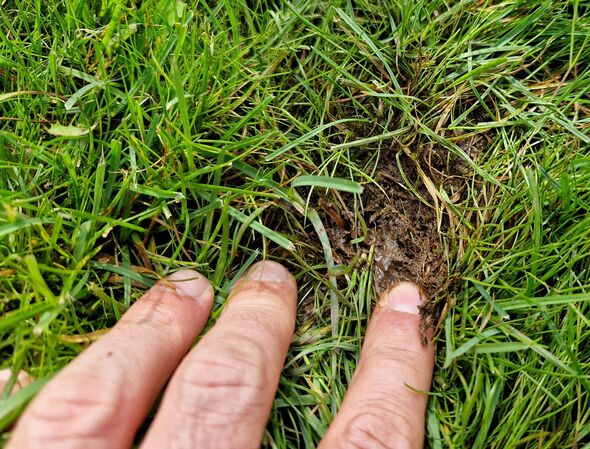Lifestyle
Lawn Care Expert Shares Solutions for Brown Patches Ahead of Autumn

Maintaining a healthy lawn can be a challenge, particularly as summer transitions into autumn. Homeowners often face issues such as discoloured brown patches that indicate the grass needs extra care. According to horticultural specialists, these problems can arise from various factors, including weather conditions and lawn maintenance practices.
Phil Catron, president and founder of NaturaLawn of America, highlighted that during the summer months, both drought and excessive moisture can damage grass. In an interview with Martha Stewart, he noted that warm, humid conditions often lead to fungal infections, which can severely impact lawn health. These issues typically manifest as distinct brown patches, often linked to three common diseases.
Common Fungal Diseases Affecting Lawns
The first condition, known as brown patch disease, creates irregularly shaped areas of discoloured grass blades. This is most noticeable when the turf becomes waterlogged. Another issue, summer patch, causes grass to yellow and then die off, resulting in unattractive brown spots. Lastly, pythium blight, also referred to as “grease spot” or “cottony blight,” can devastate lawns under warm, moist conditions. This disease creates sunken, brown zones on the grass, often accompanied by a slimy coating.
Catron emphasized that there is no one-size-fits-all solution for treating these diseases. He recommended improving air circulation and soil drainage as initial steps. Excessive fertilization can worsen the situation, so he suggested using fungicides judiciously. Consulting a local gardening specialist can help identify the specific type of fungus and recommend the most effective treatment. Catron advised, “Keep an eye on lawn conditions and be proactive about addressing any signs of disease to minimise damage and improve recovery chances.”
Repair Strategies for Affected Lawns
If brown patches are due to fungal infections, prompt action is essential. Leaving the issue untreated can lead to further grass loss. The Royal Horticultural Society suggests a gradual approach to repairing damaged areas. Diseased sections can be treated with fungicide, followed by reseeding or patching with healthy turf. Homeowners can either use turf from another part of their lawn or purchase fresh turf for immediate results. The RHS noted, “The latter gives instant results, but sowing seed may be easier and cheaper if you have no spare turf to use as a patch.”
In some cases, brown patches may not stem from fungal infections. Gardening expert Lucie Bradley from Easy Garden Irrigation pointed out that pet urine can also damage grass due to its high nitrogen content. While small amounts can act as fertiliser, concentrated exposure can burn the grass and create dead patches. Homeowners can reseed and patch areas affected by pet urine, but prevention is key to maintaining lawn health.
As autumn approaches, taking proactive steps to care for lawns will help ensure they remain healthy and vibrant throughout the changing seasons. By addressing issues promptly and employing the right strategies, homeowners can recover their lawns from unsightly brown patches and enjoy a flourishing outdoor space.
-

 Health3 months ago
Health3 months agoNeurologist Warns Excessive Use of Supplements Can Harm Brain
-

 Health4 months ago
Health4 months agoFiona Phillips’ Husband Shares Heartfelt Update on Her Alzheimer’s Journey
-

 Science2 months ago
Science2 months agoBrian Cox Addresses Claims of Alien Probe in 3I/ATLAS Discovery
-

 Science2 months ago
Science2 months agoNASA Investigates Unusual Comet 3I/ATLAS; New Findings Emerge
-

 Science2 months ago
Science2 months agoScientists Examine 3I/ATLAS: Alien Artifact or Cosmic Oddity?
-

 Entertainment2 months ago
Entertainment2 months agoLewis Cope Addresses Accusations of Dance Training Advantage
-

 Entertainment5 months ago
Entertainment5 months agoKerry Katona Discusses Future Baby Plans and Brian McFadden’s Wedding
-

 Science2 months ago
Science2 months agoNASA Investigates Speedy Object 3I/ATLAS, Sparking Speculation
-

 Entertainment5 months ago
Entertainment5 months agoEmmerdale Faces Tension as Dylan and April’s Lives Hang in the Balance
-

 World3 months ago
World3 months agoCole Palmer’s Cryptic Message to Kobbie Mainoo Following Loan Talks
-

 World4 weeks ago
World4 weeks agoBailey and Rebecca Announce Heartbreaking Split After MAFS Reunion
-

 Science2 months ago
Science2 months agoNASA Scientists Explore Origins of 3I/ATLAS, a Fast-Moving Visitor









